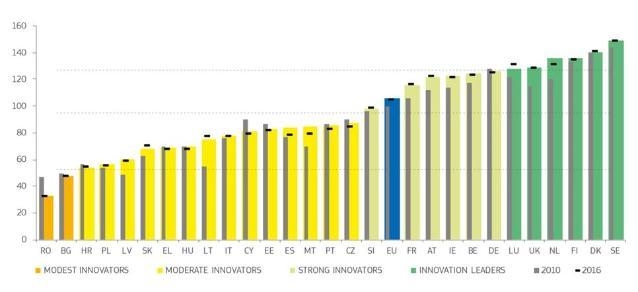The Commission’s 2018 European Innovation Scoreboard published today shows that the EU’s innovation performance continues to improve, but further efforts are needed to ensure Europe’s global competitiveness.
Every year, the Commission publishes a comparative assessment of the innovation performance of Member States and benchmarks it with international competitors. The data helps Member States, and the EU as a whole, assess in which areas efforts need to be focused.
Elżbieta Bieńkowska, Commissioner for Internal Market, Industry, Entrepreneurship and SMEs, said: “The 2018 Scoreboard shows again that Europe has a wealth of talent and entrepreneurial spirit, but we must do better at turning this excellence into success. The EU, Member States, regions and industry, including our many SMEs, have to work together to increase the allocative efficiency of our economy, improve the functioning of the internal market and help ensure that Europe remains at the international forefront of innovation.”
Carlos Moedas, Commissioner for Research, Science and Innovation, added: “This edition of the Scoreboard shows yet again that Europe is strong in science but underperforming on innovation. The renewed agenda for research and innovation sets out a range of measures for Europe to become a global innovation leader. Our proposals for Horizon Europe, the next EU research and innovation programme, will accelerate innovation along the full value chain and support the identification and scale-up of breakthrough innovations.”
This year’s edition of the European Innovation Scoreboard reveals a positive trend in the majority of EU countries – most notably in Malta, the Netherlands, and Spain, with Sweden remaining the EU innovation leader. The EU is catching up with key competitors such as Canada, Japan and the United States. But closing this innovation gap and maintaining the lead over China will require a concerted effort to deepen Europe’s innovation potential.
The findings corroborate the Commission’s recent Renewed Agenda for Research and Innovation – a call on EU leaders to act now to help Europe become the global innovation powerhouse that it has the potential to be. EU leaders held an informal discussion on 16 May in Sofia, and are expected to formulate conclusions during the 28-29 June European Council. To contribute to Europe’s global leadership in innovation, on 7 June the Commission proposed the most ambitious EU research and innovation funding programme yet, Horizon Europe, with €100 billion proposed for 2021-2027. But EU funding alone will not suffice. To maintain and improve the European way of life, a concerted effort by the public and private sector is required.
The 2018 European Innovation Scoreboard: key findings
- Sweden is once again the EU innovation leader, followed by Denmark, Finland, the Netherlands, the United Kingdom, and Luxembourg which joins the top innovators group this year. Germany drops to the group of strong innovators.

European Innovation Scoreboard 2018 country ranking. Axis Y: innovation performance in 2017 (coloured columns), 2016 (horizontal hyphens) and 2010 (grey columns) relative to EU average in 2010 – aggregate of 27 indicators; Axis X: EU countries
- On average, the innovation performance of the EU has increased by 5.8% since 2010. Over the last 8 years, innovation performance increased in 18 EU countries and decreased in ten. Performance has increased most in Lithuania, Malta, the Netherlands and the United Kingdom while it decreased most in Cyprus and Romania.
- At the global level, the EU is catching up with Canada, Japan and the United States. The EU maintains its lead over China, but this lead is decreasing rapidly with China having improved almost three times as fast as the EU. Relative to South Korea, the EU has been falling behind, but a gradual catch-up is expected over the next years.
- In selected areas of innovation, the EU leaders are:
- Denmark – human resources and innovation-friendly environment;
- Luxembourg – attractive research systems;
- France – finance and support;
- Ireland – innovation in SMEs, employment impacts, and sales impacts;
- Belgium – innovation linkages and collaboration.
- Innovation performance has improved most in the area of broadband penetration, human resources, and the attractiveness of research systems, especially through international co-publications.
- Public R&D expenditures as a share of GDP remain below their 2010 level.
- Over the next two years, the EU’s overall innovation performance is expected to improve by 6%.
Background
About two-thirds of Europe’s economic growth over the last decades has been driven by innovation. With only 7% of the world’s population, Europe accounts for 20% of global R&D investment, produces one third of all high-quality scientific publications, and holds a world leading position in industrial sectors such as pharmaceuticals, chemicals, mechanical engineering and fashion. Europe is also strong in supporting innovation through Key Enabling Technologies, such as photonics and biotechnology.
But Europe is also lagging behind in many areas. EU companies spend less on innovation than their competitors. Venture capital remains underdeveloped in Europe, resulting in companies moving to ecosystems where they have better chances to grow fast. Public investment across the EU falls short of 3% GDP target. R&D intensity is still uneven among EU regions, with investment and research heavily concentrated in Western Europe. And 40% of the workforce in Europe lacks the necessary digital skills.
The annual European Innovation Scoreboard provides a comparative assessment of the research and innovation performance of the EU countries and selected third countries. It analyses the relative strengths and weaknesses of national research and innovation systems and helps countries assess areas in which they need to concentrate their efforts to boost their innovation performance.
More information: http://europa.eu/rapid/press-release_IP-18-4223_en.htm
Share this...




